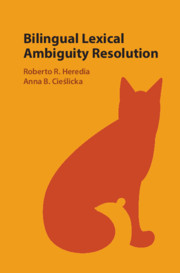Book contents
- Bilingual Lexical Ambiguity Resolution
- Bilingual Lexical Ambiguity Resolution
- Copyright page
- Dedication
- Contents
- Figures
- Tables
- Contributors
- Preface
- Acknowledgments
- Part I Theoretical and Methodological Considerations
- Part II Bilingual Lexical Processing
- 4 Cognate Processing Effects in Bilingual Lexical Access
- 5 Translation Ambiguity
- 6 Lexical Selection and Competition in Bilinguals
- Part III Bilingual Sentence Processing
- Part IV Neuroscience of Bilingual Lexical Access
- Author Index
- Subject Index
- References
5 - Translation Ambiguity
from Part II - Bilingual Lexical Processing
Published online by Cambridge University Press: 24 December 2019
- Bilingual Lexical Ambiguity Resolution
- Bilingual Lexical Ambiguity Resolution
- Copyright page
- Dedication
- Contents
- Figures
- Tables
- Contributors
- Preface
- Acknowledgments
- Part I Theoretical and Methodological Considerations
- Part II Bilingual Lexical Processing
- 4 Cognate Processing Effects in Bilingual Lexical Access
- 5 Translation Ambiguity
- 6 Lexical Selection and Competition in Bilinguals
- Part III Bilingual Sentence Processing
- Part IV Neuroscience of Bilingual Lexical Access
- Author Index
- Subject Index
- References
Summary
This chapter provides a critical overview of translation ambiguity, which arises when bilinguals are confronted with a situation in which more than one translation is possible for a given word. We first discuss the sources of translation ambiguity, its prevalence, and the methods for measuring it. We then describe the consequences of translation ambiguity for lexical processing and learning. Finally, we explore how translation ambiguity can be modeled in the bilingual mental lexicon and discuss the possibility that bilingualism is another expression of ambiguity in which the bilingual mind is constantly activating multiple meanings in translation.
Keywords
Information
- Type
- Chapter
- Information
- Bilingual Lexical Ambiguity Resolution , pp. 96 - 125Publisher: Cambridge University PressPrint publication year: 2020
References
Further Reading
References
Accessibility standard: Unknown
Why this information is here
This section outlines the accessibility features of this content - including support for screen readers, full keyboard navigation and high-contrast display options. This may not be relevant for you.Accessibility Information
- 9
- Cited by
